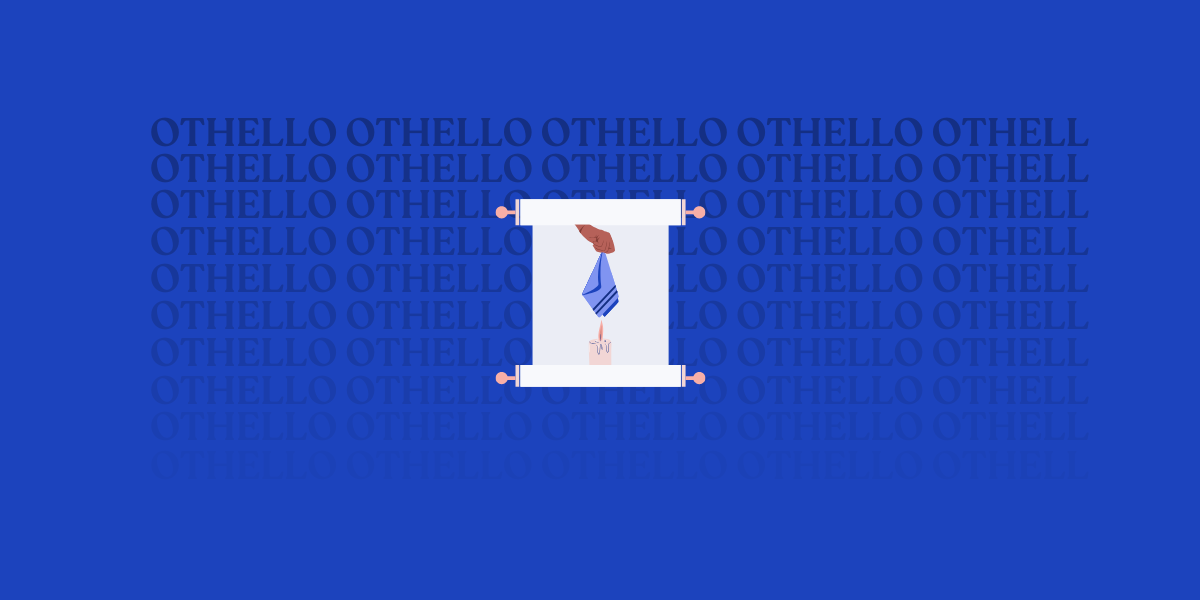
Othello
Published on
November 26, 2025

Table of Content
Text guide: Othello
Othello is a play that has transcended time. Through Shakespeare’s capacity to combine the tragic form with manipulations of language, he explores love, death, deception and ego within characters that have generated centuries of critical discourse, lasting long past its first 1604 performance.
It may seem daunting to begin writing an essay to this mammoth play, but have no fear! This text guide aims to familiarise you with all the essential elements of Shakespeare’s tragedy Othello; and unlike the villainous Iago, you can certainly trust us and our state-ranking advice. We will break down context, form, and key themes to help you understand why Othello is a significant text and why it has resonated through time – key parts of the Module B rubric.
Let’s jump in!
Part 1: Context
To understand Shakespeare’s purpose in writing Othello (a crucial aspect of textual integrity), we have to appreciate his context and the conditions that he was writing within. Let’s dive into the most important contextual considerations for Othello that you’ll need to include in your essays!
Racism and “The Moor”
First, let’s address the elephant in the room. Othello is a black man frequently referred to as “the Moor”, a derogatory nickname reflecting the racial attitudes of Shakespeare’s era. By the early 17th century, Britain had expanded their trade routes into Africa and the Middle East. This included Mauritania in Northwest Africa where the word “Moor” was derived, a broad racial term that could refer to North African, Muslim, or Black individuals. The Othering of black individuals was furthered by narratives of native barbarism which justified the emerging Transatlantic slave trade. Poorly translated travelogues such as Leo Africanus’ Description of Africa (1550) also contributed to stereotyped, negative portrayals of Moorish people. Othello, however, disrupts preconceptions of his race; he is intelligent, noble and honest (to a fault), compared to Iago who is morally “black”. Whilst Moorish characters were present in Elizabethan theatre, none had previously been allowed to demonstrate the heroism and authenticity of Othello.
Venice and Cyprus
Setting is crucial to analyse in Othello, as the play begins in Venice but shifts to Cyprus. These two settings are vastly different, and it is important to understand how they symbolise the play’s shift from civility and cultivation to the tragedy that unfolds in Cyprus. Let’s first understand what Venice would have represented for Shakespeare’s audience. Shakespeare wrote in the early 17th century, when Venice’s massive naval power led to its dominance in trade and thus extreme wealth and refinement. However, the cultural sophistication of Venice was underscored by a dark underbelly of decadence, corruption and promiscuity, particularly due to the presence of courtesans. Shakespeare’s Jacobean audience would have been aware of this duality, so consider how the initial setting intentionally foreshadows the tension between appearance, reality, and sight.
In Act 2, Othello, a Venetian, arrives in Cyprus to fight, mirroring the real 1570-73 war between Christian Venice and the Muslim Ottoman Empire. The war ended in Venice losing Cyprus to the Ottomans, representing a geopolitical shift in the Mediterranean, where the Christian world felt increasingly threatened by the Muslim Ottoman Empire. For a Jacobean audience cognizant of Cyprus’ real-life fall to the Ottomans, the tragic poisoning of Othello’s mind could symbolise the loss of “civilisation” they associated with the island’s capture by a Muslim power.
Cyprus is thus where most of the tragedy unfolds, where the worst facets of humanity are revealed, and where the characters seem bestial, primitive and malevolent.
Women and gender roles
Shakespeare infuses Othello with Jacobean gender roles despite its foreign setting. Marriage was a property transaction, with the groom chosen by the bride’s father; to elope without the bride’s father’s permission, like Othello and Desdemona, would be seen as an act of theft. Furthermore, class shaped the female experience as well; lower-class women often had more companionate, equal marriages, and similarly experienced more freedom in speech and behaviour. Note the way that Bianca and Emilia behave in the play, compared to the tragic, untouched goodness of Desdemona.
There were also strong female expectations for purity and chastity; sex was to remain strictly within marriage. To be cuckolded (cheated on) was a humorous staple of Early Modern popular culture; however, a man that was cuckolded suffered a huge loss of reputation as it symbolised a failure in their masculinity. Othello’s disintegrating mental state after being convinced of Desdemona’s adultery emphasises Jacobean anxieties about masculine reputation.
Part 2: Form
Form is an exceptionally important aspect of the play to mention in your essay! It serves a crucial role in constructing a text’s textual integrity, ensuring that all parts of a text serve to uphold a unified purpose.
The tragedy
Othello is an Aristotelian tragedy. In crafting your essay, consider incorporating analysis of these three key tragic elements:
First, the hamartia: the fatal flaw of the tragic hero which catalyses his misfortune. There are many elements that form Othello’s hamartia: propensity for jealousy, misplaced trust in Iago, deep-seated insecurities, and fragile masculine ego.
Second, the moment of anagnorisis: a profound realisation of the true nature of something that comes too late. This occurs when Othello realises that he has murdered his wife for no justifiable reason.
Lastly, catharsis: a deeply emotional release from tension, illustrated through Othello’s final monologue and ultimate suicide.
The Medieval Morality Play
In Othello, Shakespeare draws on common features of medieval morality plays that would have been familiar to his Jacobean audience. In such plays, a protagonist is surrounded by both vices and virtues, who tempt him into sin and morality respectively; typically the protagonist repents and morality is restored in the end. Thus Othello can be seen as a fight for Othello’s soul between the angelic Desdemona and the devilish Iago. As you write your essay, consider how Shakespeare constructs Iago to be the embodiment of the devil. However, as Iago ultimately triumphs, he subverts the traditional, didactic conclusion of the medieval morality play and constructs a far more complex story. Shakespeare delves into the fear, ego and insecurity that can infect anyone, using elements of the medieval morality play to remind us of our own vulnerabilities.
Prose and Verse
Shakespeare’s manipulation of language in Othello is incredibly deft. The play is written in both prose (normal written language) and blank verse (unrhymed poetry in iambic pentameter), and Othello switches between the two depending on his mental state. Most of Othello’s monologues in Acts 1 and 2 are in blank verse, and his powerful, stately speeches shape him as dignified and noble in contrast to Jacobean racial preconceptions. However, from Act 3, Scene 3, Othello’s poetic verse breaks down. His words become scrambled and repetitive, and he uses increasingly animalistic language that reflects the savagery white Venice sees within him. Ultimately however, in his final soliloquy, Othello reverts to his initial eloquence in an attempt to control his legacy before he commits suicide.
Part 3: Themes
Let’s now discuss some of the main themes of Othello.
Othello, race and reputation
Shakespeare disrupts simplistic binaries of race through his masterful construction of Othello, a black man who is noble and intelligent, yet deeply impacted by his Othering in white society. The societal obsession with reputation and status also feeds into Othello’s internalised racism and eventual tragic downfall.
Some quotes you might want to include:
- Iago’s racist narratives: “An old black ram / Is tupping your white ewe” (A1S1)
- Othello’s initial eloquent and poetic language: “My parts, my title, and my perfect soul / Shall manifest me rightly” (A1S2)
- The change in Othello’s language throughout A3 and 4: “Her name, that was as fresh / As Dian’s visage, is now begrimed and black / As mine own face.” (A3S3)
- Othello’s final soliloquy and attempt to redeem his reputation: “one that loved not wisely, but too well; / Of one not easily jealous, but being wrought.” (A5S2)
Iago’s duplicity
In your essay, it is crucial to unpack Iago’s villainy and how he is constructed as a Machiavellian character and even - under certain interpretations – evil incarnate. Through manipulating human vulnerabilities, he controls and ultimately corrupts Othello’s view of the world. Shakespeare warns against a simplistic belief in reductive narratives, through Iago’s successful corruption of Desdemona’s purity in the eyes of Othello.
Some quotes you might want to include:
- Iago revealing his dishonest intentions early on: “I will wear my heart upon my sleeve / For daws to peck at. / I am not what I am” (A1S1)
- Iago’s claim to “turn [Desdemona’s] virtue into pitch, / And out of her own goodness make the net / That shall enmesh them all” (A2S3) reveals his understanding of Desdemona’s role as a status symbol in Othello’s life
- Iago’s gradual manipulation of Othello: “O, beware my lord, of jealousy; / It is the green-eyed monster…” (A3S3)
- At the end of A3S3, the stage direction of the “sacred vow” of marriage between Iago and Othello [Othello kneels…Iago kneels…] suggests how he has successfully supplanted Desdemona as Othello’s closest friend
Female agency
In Othello, Shakespeare explores and pushes the boundaries of gender roles. He reveals the reduction of women such as Desdemona into parochial binaries – Madonna or whore – within a society obsessed with status and reputation. Consider how he provokes us to interrogate the devastating consequences of this reduction.
Some quotes you might want to include:
- Jacobean and Venetian values and stereotypes of women: “white ewe”, “fair daughter” and “a maid so tender, fair and happy” describe Desdemona in A1S1 and S2
- Desdemona’s own words “so much duty as my mother showed / to you…I challenge that I may profess / due to the Moor my lord” (A1S3) only further affirms her classification as property and devotion to her new husband
- Emilia’s protofeminism, which ominously foreshadows the tragedy of the play: “They eat us hungerly, and when they are full / They belch us.” (A3S4)
- Desdemona’s final words “Commend me to my kind lord. O, farewell” (A5S2) reveal her tragic and passive acceptance of her fate
Storytelling
Othello is a story about stories; how stories can be manipulated, controlled, twisted and ultimately used to deceive. Iago is a masterful storyteller, and his control of the narratives within the play manifest through his ability to identify human vulnerabilities (Othello’s ego and jealousy), and manipulate societal narratives (racial tensions and gender roles).
Some quotes you might want to include:
- Iago using narratives of race to manipulate Brabantio: “the devil will make a grandsire of you” (A1S1)
- Iago manipulating Desdemona’s purity to deceive Othello: “I’ll pour this pestilence into his ear: / That she repeals him for her body’s lust… / So will I turn her virtue into pitch” (A2S3)
- Iago emphasising Othello’s Otherness to cement his trust in Iago: “I know our country disposition well. / In Venice they do let ⟨God⟩ see the pranks / They dare not show their husbands…” (A3S3)
- Iago’s ambiguous final words which leaves his legacy in the hands of the audience “Demand me nothing. What you know, you know. / From this time forth I never will speak word.” (A5S2)
Tragedy/form
As form is so crucial to this Module and textual integrity, you may wish to have a paragraph that centralises on form. Shakespeare’s use of the tragic form encourages his audience to look beyond simplistic facades and narratives, in order to realise the deceitful appearances within their world. His storytelling transcends time, enabling us to more richly understand the universal nature of human vulnerabilities like jealousy, ego, and love.
Some quotes you might want to include:
- The dichotomy between the settings of Venice (A1) and Cyprus (A2 onwards), imbuing the domestic plot with the danger and urgency of the military threat
- The motif of light and dark foreshadows Othello’s corruption, for example “Hell and night must bring this monstrous birth to the world's light” (A1S3)
- Iago building a close relationship with the audience through soliloquies like “And what's he then that says I play the villain?" in A2S3
- The audience acts as a jury, considering Othello’s legacy, even as he demands we see him as “One that loved not wisely, but too well; / Of one not easily jealous” (A5S2)
Part 4: Wrap-up
Hopefully this text guide provided you with a useful overview of the most crucial elements of Othello. It is a play full of miscommunication, deception and tragedy that could have been prevented if not for intrinsic failings of human nature. There is so much to unpack, but if you can prove to your marker the enduring significance of Othello, you should be well on your way to writing a 20/20 Module B essay!
.svg)



.png)



